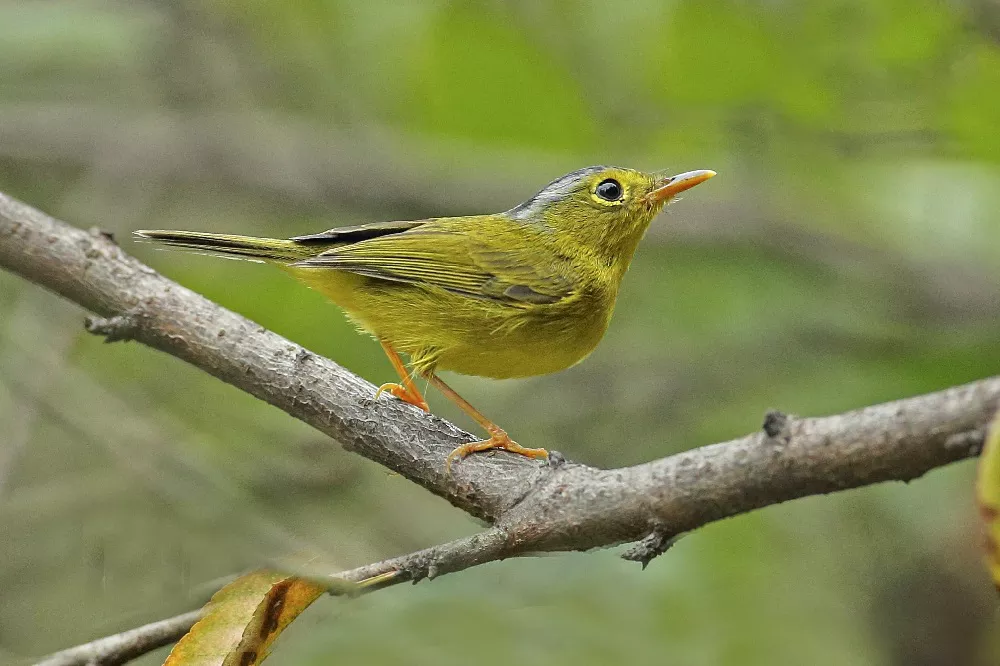The green-crowned warbler (Phylloscopus burkii) is a species of leaf warbler (family Phylloscopidae). The body length is 10~11 cm. The central crown pattern on the top of the head is gray or gray-stained green, the side crown pattern is black, and the eyes are golden yellow. The upper body is olive green, the two wings and the tail are dark brown, the large coverts have narrow yellow-green tips, forming inconspicuous wing spots on the wings, and the outer two pairs of tail feathers are white inside. The yellow eye rim is distinguished from the White-spectacled warbler and the Grey-cheeked warbler, and some subspecies have a yellow wing stripe.
What does Green-crowned Warbler look like
Male and female feathers are similar. The forehead is yellow-green or olive-green black, the central crown is gray or green, some are gray and olive-green, the side crown is black or black, from the forehead to the back; the ear feathers are dark yellow-green or olive-green on the head side, and the eyes Slightly darker at first, with golden-yellow eye circles. Back and shoulders olive green, waist and tail coverts slightly lighter; inner wing coverts the same color as back, remaining wing coverts and flight feathers dark brown, feather margin olive green; large coverts with narrow, inconspicuous Pale yellow or yellow-green tip, forming a faint wing spot, sometimes absent. Tail dark brown, feather edge olive green, and the outermost two pairs of tail feathers are white or mostly white inside. Underparts bright yellow, flanks stained with olive.
Iris brown or dark brown, mouth thick and wide, upper mouth dark gray or horn brown or black, lower mouth yellow, feet orange yellow or horn yellow.
Green-crowned Warbler habtiat
During the breeding period, it mainly inhabits evergreen or deciduous broad-leaved forests in mountains at an altitude of 1000-3000 meters, especially in sparse broad-leaved forests and bamboo forests on both sides of streams with well-developed understory shrubs. It also inhabits mixed forests and coniferous forests. In winter, it often descends to the secondary broad-leaved forests, forest edge sparse forests and shrubs of low mountains and the foot of mountains, and sometimes moves to small patches of jungle near farmland and settlements.
Green-crowned Warbler living habit
Except that it often acts alone or in pairs during the breeding period, it is mostly in small flocks at other times, and sometimes it is also seen moving and foraging with other warblers and small birds. Often hops between the branches and leaves in the undergrowth for food.
Migration: mainly resident birds, some winter migratory birds and traveling birds.
What do Green-crowned Warblers eat?
Feeds mainly on insects. The food eaten mainly includes insects and insect larvae such as beetles, golden flower beetles, scarab beetles, weevil beetles, leafhoppers, ants, crickets, bees, etc. It also eats insect eggs and a few spiders.
Distribution area of Green-crowned Warbler
It is found in the Indian subcontinent, ranging across Bangladesh, Bhutan, India, Nepal, China, and Pakistan.
Mode of reproduction
The breeding season is from May to July. Usually nests on the ground in the undergrowth or on the bushes and grass not high from the ground, and also nests on hillsides, ridges, rock slopes and rocky feet on the bank, and there are shrubs, grasses or small trees to hide near the nests. . The nest is spherical, mainly woven by moss and weed stems and leaves, with openings on the sides. The size is 10-12.7 cm x 7.5-10 cm in outer diameter, 4-5 cm x 2.5-5 cm in inner diameter, 7-14 cm high, and 5-7.5 cm deep. It is also reported that the shape of the nest is a shallow dish, which is made of thatch and moss. The size of the nest is 12-13.5 cm in outer diameter, 6.2-7 cm in inner diameter, 5.8-6 cm high, and 3.5-4.0 cm deep. Each nest lays 3~4 eggs, the eggs are white or light khaki, and the male and female parents take turns to incubate the eggs.


 Facebook
Facebook  Instagram
Instagram  Youtube
Youtube 